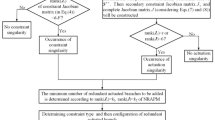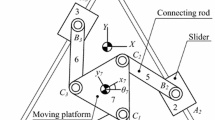Abstract
This paper proposes a 3-PPRU parallel mechanism (PM) with a completely/partially/non constant Jacobian matrix. Based on screw theory and selecting actuating components theory, the reasonability of the actuating input selection is analyzed. By different actuating selection, the Jacobian matrix of the PM can realize completely/partially/non constant. The direct, inverse and combined kinematic singularities of the PM with three different Jacobian matrices are discussed. The velocity, payload and stiffness performance of the PM are discussed and compared. A new index, as auxiliary evaluation index, is proposed first.
Similar content being viewed by others
References
S. A. Joshi and L. W. Tsai, Jacobian analysis of limited-DOF parallel manipulators, J. of Mechanical Design, 124(2) (2002) 254–258.
Q. C. Li, X. D. Sun, Q. H. Chen and C. Y. Wu, Kinematics and singularity analysis of 2-PRS-PRRU parallel mechanism, J. of Mechanical Engineering, 47(3) (2011) 21–27.
Y. G. Li, Y. M. Song, Z. Y. Feng and C. Zhang, Complete Jacobian matrix of a class of incompletely symmetrical parallel mechanisms with 4DOF, J. of Mechanical Engineering, 43(6) (2007) 37–40.
T. Huang, H. T. Liu and D. G. Chetwynd, Generalized Jacobian analysis of lower mobility manipulators, Mechanism and Machine Theory, 46(6) (2011) 831–844.
B. Hu, C. X. Song, Q. L. Zhang and J. J. Yu, Jacobian matrix establishment of 2(2-UPR+SPR) serial-parallel manipulator, China Mechanical Engineering, 26(7) (2015) 853–858.
W. Ye, Q. C. Li and K. T. Zhang, Kinematics and performance analysis of a 2R2T parallel manipulator with partially decoupled motion, Transactions of the Chinese Society for Agricultural Machinery, 50(1) (2018) 1–10.
Z. X. Shi, Y. F. Luo, H. L. Chen and M. Y. Ye, On global performance indices of robotic mechanisms, Robot, 27(5) (2005) 420–422.
X. Zhou, Y. D. Xu, J. T. Yao, K. J. Zheng and Y. S. Zhao, Complete stiffness model and stiffness performance of 5-UPS/PRPU redundantly actuated parallel machine tool, Optics and Precision Engineering, 23(4) (2015) 1070–1080.
S. G. Kim and J. Ryu, New dimensionally homogeneous Jacobian matrix formulation by three end-effector points for optimal design of parallel manipulators, IEEE Transactions on Robotics and Automation, 19(4) (2003) 731–736.
Y. Z. Zhao, Y. C. Cao, X. W. Kong and T. S. Zhao, Type synthesis of parallel mechanisms with a constant Jacobian matrix, J. of Mechanisms and Robotics, 10(6) (2018) 061011.
Y. Z. Zhao, B. W. Liang, Y. C. Cao and T. S. Zhao, 3-PRRR translational parallel mechanism with constant Jacobian matrix and its transfer performance analysis, Transactions of the Chinese Society for Agricultural Machinery, 48(1) (2017) 333–338.
Y. Z. Zhao, B. W. Liang, W. Yang, C. Wang, G. M. Chen and T. S. Zhao, The constant balancing 6UPS/(3PRRR)+S parallel mechanism and its balancing performance analysis, Mechanism and Machine Theory, 126 (2018) 79–91.
Y. Z. Zhao, Y. C. Cao, B. W. Liang, R. Han and S. Li, A Deformable Parallel Three-dimensional Dynamic Force Sensor, Patent No. 106017769B, National Intellectual Property Administration, China (2016).
Y. C. Cao, Y. Z. Zhao, T. Zhang and G. C. Ma, Construction method of parallel mechanisms with a partially constant Jacobian matrix, Mechanism and Machine Theory, 145 (2020) 103699.
Y. Z. Zhao, B. W. Liang, J. Zhang, L. Z. Qi, D. Zhang and W. Yang, The effect analysis of input selection on performance of 3-PPRR translational parallel mechanism, International J. of Robotics and Automation, 33(6) (2018) 635–644.
T. S. Zhao and Z. Huang, Theory and application of selecting actuating components of spatial parallel mechanisms, J. of Mechanical Engineering, 36(10) (2000) 81–85.
C. Gosselin and J. Angeles, Singularity analysis of closed-loop kinematic chains, IEEE Transactions on Robotics and Automation, 6(3) (1990) 281–290.
X. J. Liu, The relationship between the performance criteria and link lengths of the parallel manipulators and their design theory, Ph.D. Thesis, Yanshan University, China (1999).
J. K. Salisbury and J. J. Craig, Articulated hands: force control and kinematic issues, The International J. of Robotics Research, 1(1) (1982) 4–17.
X. J. Liu, J. S. Wang and G. Pritschow, On the optimal kinematic design of the PRRRP 2-DoF parallel mechanism, Mechanism and Machine Theory, 41(9) (2006) 1111–1130.
C. Gosselin and J. Angeles, A global performance index for the kinematic optimization of robotic manipulators, J. of Mechanical Design, 113(3) (1991) 220–226.
Q. L. Huai, Performance analysis and design on the six degree of freedom motion simulatior, M.S. Thesis, Yanshan University, China (2014).
N. N. Lin and K. M. Li, Dexterity analysis of 3-(2SPS) parallel manipulator, Machine Building and Automation, 43(6) (2014) 39–42.
Q. Hao, Optimization design and dynamic control of a 2-DoF planar parallel manipulator, Ph.D. Thesis, Tsinghua University, China (2011).
Acknowledgments
The authors would like to acknowledge the financial support of the National Science and Technology Major Project of China [grant numbers 2015ZX04005006]; the Science and Technology Planning Project of Guangdong Province, China [grant numbers 2019B040402006]; the Science and Technology Major Project of Zhongshan city, China [grant numbers 2018A10018]; the Natural Science Foundation of Hebei Province [grant numbers E2018203436]; the Science Technology Research of Higher Education of Hebei Province [grant numbers ZD2018024]; and Guangdong Province Jihua Laboratory [grant numbers Y80311W180].
Author information
Authors and Affiliations
Corresponding authors
Additional information
Tie Zhang is a Professor and a Ph.D. candidate Supervisor of the School of Mechanical and Automotive Engineering, South China University of Technology, Guangzhou, China. He received his Ph.D. in Mechanical Manufacturing and Automation from South China University of Technology in 2001. His main research interests include optimal design and control of serial and parallel robots, automation and intelligent systems.
Yanzhi Zhao is a Professor and a Ph.D. candicate Supervisor of the School of Mechanical Engineering, Yanshan University, Qinhuangdao, China. He received his Ph.D. in Mechatronics Engineering from Yanshan University in 2009. His main research interests include theory and applications of parallel mechanisms.
Rights and permissions
About this article
Cite this article
Cao, Y., Zhang, T., Zhao, Y. et al. Performance analysis of 3-PPRU parallel mechanism with a completely/partially/non constant Jacobian matrix. J Mech Sci Technol 34, 4263–4279 (2020). https://doi.org/10.1007/s12206-020-0918-5
Received:
Revised:
Accepted:
Published:
Issue Date:
DOI: https://doi.org/10.1007/s12206-020-0918-5




